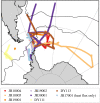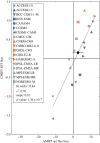Finale: impact of the ORCHESTRA/ENCORE programmes on Southern Ocean heat and carbon understanding
- PMID: 37150199
- PMCID: PMC10164468
- DOI: 10.1098/rsta.2022.0070
Finale: impact of the ORCHESTRA/ENCORE programmes on Southern Ocean heat and carbon understanding
Abstract
The 5-year Ocean Regulation of Climate by Heat and Carbon Sequestration and Transports (ORCHESTRA) programme and its 1-year extension ENCORE (ENCORE is the National Capability ORCHESTRA Extension) was an approximately 11-million-pound programme involving seven UK research centres that finished in March 2022. The project sought to radically improve our ability to measure, understand and predict the exchange, storage and export of heat and carbon by the Southern Ocean. It achieved this through a series of milestone observational campaigns in combination with model development and analysis. Twelve cruises in the Weddell Sea and South Atlantic were undertaken, along with mooring, glider and profiler deployments and aircraft missions, all contributing to measurements of internal ocean and air-sea heat and carbon fluxes. Numerous forward and adjoint numerical experiments were developed and supported by the analysis of coupled climate models. The programme has resulted in over 100 peer-reviewed publications to date as well as significant impacts on climate assessments and policy and science coordination groups. Here, we summarize the research highlights of the programme and assess the progress achieved by ORCHESTRA/ENCORE and the questions it raises for the future. This article is part of a discussion meeting issue 'Heat and carbon uptake in the Southern Ocean: the state of the art and future priorities'.
Keywords: Southern Ocean; climate; ocean carbon; ocean circulation; ocean heat; ocean–atmosphere fluxes.
Conflict of interest statement
The authors declare that they have no competing interests.
Figures












References
-
- Levitus S et al. 2012. World ocean heat content and thermosteric sea level change (0–2000m), 1955–2010. Geophys. Res. Lett. 39, 1-5. ( 10.1029/2012GL051106) - DOI
-
- Intergovernmental Panel on Climate Change (ed.). 2014. Observations: ocean pages. In Climate change 2013 – the physical science basis, pp. 255-316, 1st ed. Cambridge, UK: Cambridge University Press. See https://www.cambridge.org/core/product/identifier/CBO9781107415324A018/t... [cited 17 Aug 2022].
-
- Khatiwala S et al. 2013. Global ocean storage of anthropogenic carbon. Biogeosciences 10, 2169-2191. ( 10.5194/bg-10-2169-2013) - DOI
-
- Frölicher TL, Sarmiento JL, Paynter DJ, Dunne JP, Krasting JP, Winton M. 2015. Dominance of the Southern Ocean in anthropogenic carbon and heat uptake in CMIP5 models. J. Clim. 28, 862-886. ( 10.1175/JCLI-D-14-00117.1) - DOI
Publication types
LinkOut - more resources
Full Text Sources

